Introduction
The reported financial statements of the company do not give an in-depth analysis of the financial health of the company. Therefore, it is necessary to carry out an in-depth analysis of the financial analysis of the financial statements to have a better view of the company. Further, the results of the analysis need to be compared with those of other companies under different conditions to find out the financial stability of the company. Analysis of a company helps in making informed decision. Ratio analysis breaks down the financial data into various components for better understanding of the financial strengths and weaknesses of the company (Brigham & Ehrhardt, 2009). Ratio analysis will focus on the profitability, liquidity, efficiency, and the gearing level. The paper will result of simulation analysis for various companies. Further, the paper will also compare the simulation results of the companies.
Analysis of various financial statistics
Profitability ratios
Profitability ratios give an indication of the earning capacity of an entity. The ratios measure the effectiveness of a company in meeting the profit objectives both in the long run and short run. The ratios show how well a company employs its resources to generate returns. Profitability ratios are discussed below.
Return on sales (ROS)
Return on sales measures the ability of an entity to manage the costs of operating the business to earn sales. The return on sales shows how much profit is generated for each unit of sales. Return on sales is computed as shown below.
- Return on sales = net income / sales
- Gross profit margin = gross profit / sales
- Operating profit margin = income before interest and taxes / sales
In the first round, Digby had the highest ROS at 10.5% while in the eighth round of simulation Andrew had the highest ROA at 25.75%. However, Andrew Corporation showed improvement in ROA. In round one, the company had a return on assets amounting to 2.28%. This improved to 25.75% in round eight. This was attributed to use of minimal amounts of variable resources and efficient use of available fixed assets. Further, the improvement was attributed to a change in management skill such as changing the staffing of the company to improve efficiency. Thus, based on the results of the simulation, none of the companies provided consistent result. Thus, there is a need to carry out review of return on sales for a longer period to make sure that the trend in performance is consistent. Further, high return on assets is favorable. The graph below shows the history of ROS.
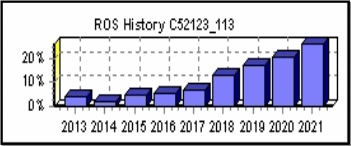
Return on assets (ROA)
Return on assets (ROA) measures the efficiency of the use of total assets of a company. An increase in return on assets is favorable since it shows that the ability of the company to manage fixed assets to generate sales and income. High values of return on assets are favorable since it shows that the company is efficient in managing assets to generate profit. It also implies that the management of the company is keen to invest in assets that can generate sales (Brigham & Ehrhardt, 2009). Computation of return on assets is shown below:
Return on assets = net income / total assets
From the simulation results, the trend of return on assets had the same trend as return on net sales. For instance, in the first simulation, return on total assets for Digby was the highest at 11.92% while return on assets for Andrew amounted to 2.77% However, in the last round, Digby had 10. 50% while Andrew had the highest amounting to 25.59%. The significant increase in the return on assets of Andrew was as a result of increase in the in the total asset base by a large margin. The total assets increased from $141,402,111 in round one to $554,022,022 in round eight. On the other hand, total assets for Digby increase from $112,218,854 in round one to $115,710,617. Therefore, it is clear that the total assets of Andrews increased by a large margin than that of Digby hence high return on assets. The graph below shows the history of return on assets for Andrew.
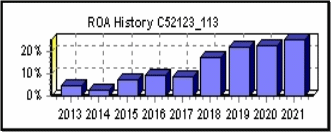
Return on equity (ROE)
Return on equity measures how efficiently the company manages shareholder’s equity to generate net income. It is in the interest of shareholders that the management needs to manage the shareholder’s wealth efficiently to maximize income (Brigham &Ehrhardt, 2009). Return on equity is computed as shown below. Shareholders’ equity = net income / shareholder’s equity. From the simulation results, Digby had the highest value of return on equity amounting to 22.03%. While Andrew had a return on equity amounting to 6.43% on the first simulation. On the eighth simulation, Digby had a return on equity amounting to 21.64% while Andrew had 32.27%. This can be attributed to an increase of the amount of sales by a large margin for Andrew. For instance, sales for Andrew increased from $171,210,600 in round one to $550,480,917 in round eight while sales for Digby increased from $127,434,322 in round one to $230,274,353 in round eight. Thus, it is clear that an increase in sales by a large margin increases the amount return to equity while holding the total equity constant. However, as the value of the total amount of shareholder’s equity increases, the return on equity will decrease. Investors and shareholders would prefer a high ratio of return on equity. The graph below shows the trend of change in return on equity for Andrews.
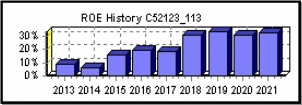
Leverage
A company’s leverage is explained by the amount of debt financing it holds. The ratios are vital since they show the investors the extent of exposure of equity financing. A commonly used ratio is the debt to equity ratio. A high leverage ratio is not favorable since it scares away capital providers. It is because high ratios imply an increase in interest fee. This reduces the income attributable to shareholders. On the other hand, very low ratios are not favorable since they show that the management of the company is not willing to exploit the potentials of the company. A commonly used ratio used is the debt to equity ratio (Brigham & Ehrhardt, 2009). The formula for computing debt to equity ratio is shown below.
Debt to equity ratio = total debt / total equity
The table below summarizes the values for debt/equity ratio.
From the table above, it is clear that the company is highly levered. In the first round, the total amount of debt financing is more than the total amount of equity. This can be attributed to the need to have a large amount of capital for growth and expansion. However, the leverage of the company is declining over the years. This is a good sign. The trend of debt/equity ratio is shown below.
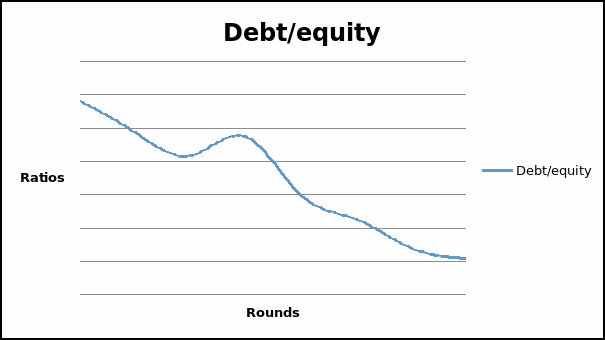
Sales
The amount of sales of the company is vital since it forms the basis of preparing the financial statement of a company. Besides, the amount of sales is a strong indicator of the profitability of a company. Sales are earned from normal operating of a business. It is the revenue generated from the process of selling goods and services in which a company trades in. From the report of simulation, the company with the highest amount of sales in the first simulation was Digby amounted to $127,434,322. Baldwin had the least amount of sales in the first simulation amounting to $91,296,627. The company of interest is Andrew. It had sales amounting to $171,210,600. In the last simulation, Andrew had the highest amount of sales totaling to $550,480,917. The total amount of sales for Digby increased by a small margin to $230,274,353. The sales for Baldwin increased by a slightly larger margin than the amount of sales for Digby. The rate at which the amount of sales of a company grows highly depends on the strategy adopted by a company. Advertisement has a greater impact on the amount of revenue earned by a company more than other factors. For instance, in the eighth simulation, Andrew spent the highest amount on the selling, general and administration expenses totaling to $33,438,001. Thus, we can deduce that there is some degree of direct relationship between selling, administration and general expenses and the total amount of sales earned by a company.
Another key reason that can give to the variation in the amount of sales is the size of competition. A firm operating in a highly competitive industry is likely to have volatile sales. This is because competition has the impact of causing volatile sales. Market share of companies is measured using a number of variables. Commonly used variables are the amount of sales and total assets. The market of Andrew is expected to increase for some time until the company reaches the maturity stage (Brigham & Ehrhardt, 2009). After reaching maturity, the sales and market share are expected to grow at a declining rate. The graph below shows the market share of the company.
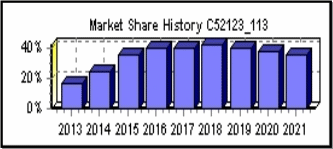
Trend of the sales values
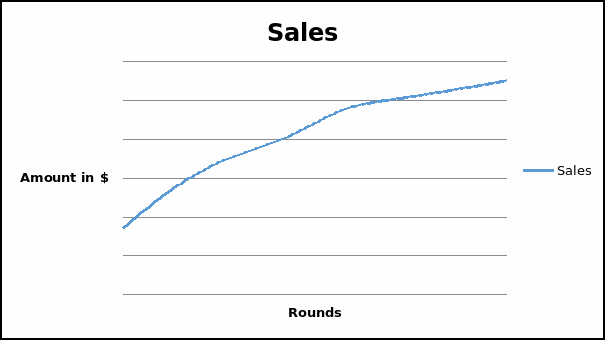
From the graph above, it is clear that trend of sales is the same as the trend of the market share. It first grows at increasing rate then increases at a declining rate. Profits Profit is denoted as the difference between the total revenue earned and the total incurred within a given financial period usually containing twelve months. The amount of profit earned is not only determined by amount sales but also on how the company manages the cost of running the business. Failure to manage costs effectively may result in losses (Brigham & Ehrhardt, 2009). In the first round of the simulation, Digby had the highest amount of profit amounting to $13,378,958. The profitability of Andrew amounted to $3,910,921. In the last simulation, the profitability that Andrew had improved by a high percentage. The profitability of the company amounted to $141,766,960 while the profitability of Digby declined to $12,155,300. From the comparisons above, it is clear that the strategies adopted by a company have a significant impact on the profitability of a company. The strategies relate to the mix of total capital, equity, sales and expenses. It is worth noting that the amount of the capital base of a company has a direct impact on profitability. The graph below shows the rate at which the amount of sales of Andrew grew over the period.
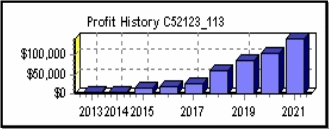
Trend of profitability
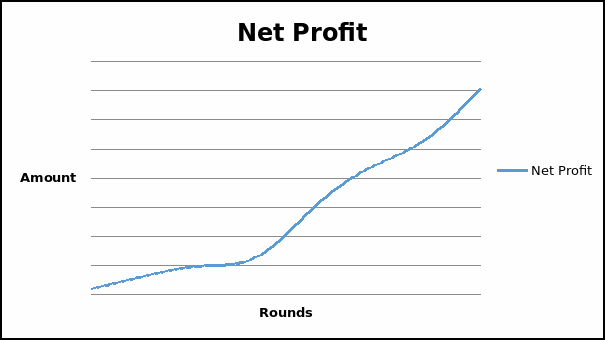
Financial standing
The financial standing of the company will focus on the nature and pattern of cash flow. It will also analyze the liquidity position of the company using current ratio. The section will also look at the key financial statements of the company.
Cash flow statement
A cash flow statement captures the movement of cash in an organization. From the simulation analysis of Andrews, the first round yielded a change in cash amounting to $24,357 while that of Digby amounted to $23,196. The change in cash during the rounds of simulation was erratic. For instance, in the seventh round, the company had a negative change in cash flow amounting to ($51,156). However, the last cash flow yielded a positive change in cash flow amounting to $78,058 while that of Digby amounted to $5,406. The amount of net cash change at the end of the year highly depends on the financing and investing decision undertaken by the company. For instance, in the seventh round, the management of the company decided to carry out plant improvement, pay dividends, retire stock, and repay loans. All these involve a cash outflow. It is worth mentioning that the cash flow from operating activities increased over the years. In the first round, it amounted to $12,363 while for Digby amounted to $20,542. In the last round, it increased to $187,549 while for Digby increased to $26,837. The value is arrived at after adjusting the net income with depreciation, changes in current assets and liabilities.
The changes in cash flow from investing activities were majorly generated from plant improvement. The total amount spent on plant improvement was erratic over the years. Generally, the values were declining over the years. This was majorly attributed to stock retire and repayment of debt starting from the fourth year. The value in the first round amounted to $37,994. In the last around it amounted to ($43,891). There were no changes in cash flow from investing activities for Digby Company. In the first round, the net changes in cash amounted to $24,357 for Andrews while for Digby amounted to $23,196. In the last round, the net cash changes amounted to $84,618 for Andrews while for Digby amounted to $5,406. Monitoring cash flow is significant since it determines the liquidity of a company. The graph below shows the trend of various elements of cash flow statement for the company.
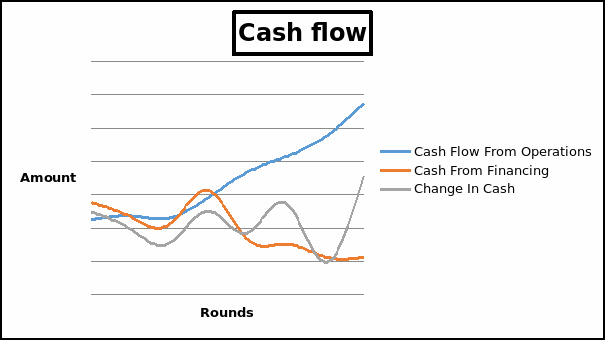
Current ratios
The common liquidity ratios are the current ratio and quick ratio. The current ratio is calculated as shown below.
Current ratio = current asset / current liabilities
The table below summarizes the current ratios for the company.
From the table above, the current assets increased from $48,855 to $153,324. The current liabilities declined from $19,855 to $18,735. The resulting current ratio increased from 2.46:1 in round on to 8.18:1 in round eight. It was higher than the current ratio for Digby which was $2.34:1 in the first round and 6.8:1 in the last round. The liquidity ratio for the company in the last round is extremely high. The high current ratio could be a sign that assets are tied in items that are not generating income. Thus, the amount of money tied in the current assets should be channeled to other assets that can generate income. This can be achieved by reducing the amount of current assets in the balance sheet. Therefore, the management needs to manage the future liquidity so that minimum assets are maintained as liquid assets (Holmes & Sugden, 2008).
Balance sheet
The balance sheet is a statement which summarizes the financial position of a company. From the results of simulation of the balance sheet of the company, total cash in the first round amounts $27,791 while in the last round it amounts to $84,618. This is equal to 204.48% increase over 10 years. Also, accounts receivable increased from $14,072 in round one to $67,868 in the last round. It is equal to 382.29% increase. The total amount of inventory declined from $6,992 in round one to $838. It is a decline of 88.01% for all the ten years. These components resulted in an increased of current assets from $48,855 in round one to $153,323 in round eight, a 213.83% increase. The current assets for Digby increased by a small margin from $43,939 in the first round to $72,711 in the last round. The decline in the amount of inventory can be as a result of the need to cut the amount of money held in liquid assets. It is a good sign since it reduces the amount of storing goods. The amount of plant and equipment increased from $139,800 in round one to $625,600 in the last round. It is a 347.50% increase. The increase in plant and machinery resulted in an increase of accumulated depreciation from $47,253 in round one of the simulation to $224,901 in round eight. It is equal to 375.95% increase. Increasing the amount of productive fixed assets is important since it contributes to growth in sales.
Similarly, total assets grow from $141,402 in round one to $554,022 in round eight. It is an increase of 291.81% while the total assets for Digby increase by a small margin of $112,219 in the first round to $115,711 in the last round. From the statement of financial position, the total liabilities are made up of accounts payable, current debt and long-term debt. The total current debt declined from $10,000 in round one to $0 in the last round. It is a decline of 100%. The accounts payable increases by a small margin that is, from $9,855 to $18,735 in round eight. It is an increase of 90.11%. The long-term debt increases by only 58.16% that is, from $60,694 in round one to $95,994 in the last round. Total liabilities increase by 42.43%, that is, from $80,549 in round one to $114,729 in round eight while for Digby increased from $51,495 in the first round to $59,537 in the last round. The amount of common stock increased by 19.52% that is, from $27,360 to $32,697. The retained earnings increase by a large percentage that is 1,113.97%.
The shareholder’s equity increases by 621.89% that is, from $60,853 in round one to $439,293 in round eight while for Digby declines from $60,724 in the first round to $56,174 in the last round. The significant growth in the shareholders’ equity can be attributed to the massive growth of retained earnings. It is clear that the company is reducing the amount of debt in the capital structure while increasing the amount of equity financing by a large margin. This reduces the leverage to minimal levels. From the simulation analysis, it is clear that all values in the balance sheet are increasing throughout the simulation period. Thus, the capital base in the company will also increase. An increase in the amount of capital contributes to the growth of the company. The graph below shows the trend of the balance sheet values for the eight rounds. Income statements
The income statement shows the items that are deducted from the sales of a company to arrive at the net income. All the financial statements of a company are interrelated. The output of one statement is the input of another statement. For instance, the net income from the income statement is added to the shareholder’s equity when preparing the balance sheet. The output of a balance sheet is used to generate the cash flow statement. Also, net income, from the income statement, is used to prepare the indirect statement of cash flow. Thus, a company does not manage the elements in the income statements, the financial position of the company and the net cash changes will be affected. As mentioned above, the net sales increase from $171,211 in the first round of simulation to $550,481 in the eighth round while for Digby also increases from $127,434 in the first round to $230,274 in the last round. The total variable cost is also increases from $122,371 in round one to $240,339 in round eight. It is an increase of 96.40%. Similarly, the variable cost for Digby increases from $81,239 in the first round to $176,344 in the last round. The total variable costs are made up of direct labor costs, direct materials and inventory carrying cost. The direct labor cost declined by 11.21% during the eight rounds of simulation. However, direct material cost increased by 182.67% during the sounds while inventory carrying cost declined by 87.96%. This can be attributed to the decline in the amount of closing inventory. The resulting contribution margin is expected to increase from $48,840 in round one to $310,142 in the last round. It is a 535.02% increase. Further, the total period costs increased from $32,888 in round one to $75,135 in the last round of simulation. The period cost is made up of depreciation, research and development, promotion, sales, and administration. The amount of depreciation increased by 347.50%. This can be attributed to an increase in the amount of plant and machinery over the years. The amount spent on research and development increased by 33.38% whiles the total expenditure on promotion declined by 16.67%. Sales and administration expenditure increased by 53.06% and 309.93% respectively. The earnings before interest and taxes increased from $14,552 in the first round to $234,053 in the last round while for Digby also declines from $26,593 in round one to $25,050 in round eight. As earnings before interest and tax increases, the amount of taxes to be paid by the company also increases. The net profit of the Andrew increases from $3,911 in the round one to $141,767 in the last round. It is an increase of 1,508.39%. However, the net profit of Digby declines from $13,379 in round one to $12,155 in round eight. The total amount of interest of interest expense for both long term and short term debt increases by a small margin that is by 36.70% over the ten year period. The amount of taxes also increases by a large margin that is, by 3,524.66%. This is a result of a massive increase in the amount of EBIT. The resulting net income increases from $3,911 in round one to $141,767 in the last round. This is equal to 3,524.83% increase. The graph below shows the trend of the values.
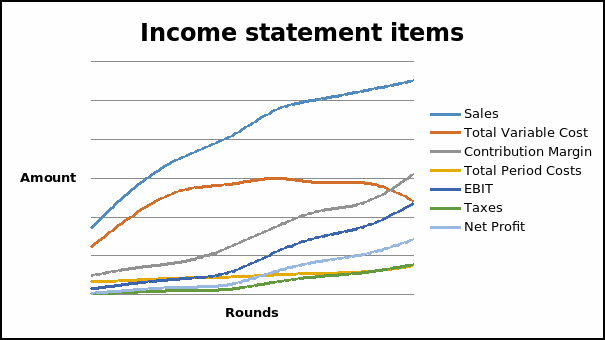
As much as all the values in the income statements are increasing, the graph above shows that the values are increasing at different rates in different rounds. For instance, sales increase at a decreasing rate between round one and four thereafter, it starts increasing at a declining rate. Other items such as contribution margin, EBIT, and net profit first increase at a declining rate and then at an increasing rate. The difference in trend is as a result the trend of the total variable cost. Thus, the management needs to negotiate for better costs of direct labor and direct material cost to make sure that a profit is realized in the early years as opposed to late years. Also, the management can also change inventory holding policy to reduce the amount of inventory carrying cost. For instance, the management can decide to use Just-in-Time policy as opposed to the current policy (Holmes & Sugden, 2008).
Analysis of the company’s stock price
Ending stocks price
Stock price is the amount paid in exchange for gaining a proportion in the ownership of the company. The stock price of a company depends on a number of factors. The key reason is the profitability and the financial position of the company. This can be found in the financial statements of the company. The second reason is the news from both external and internal sources of the company. This is likely to affect the performance of the company. Another important factor is the dividends paid by the company. From the simulation results, the ending stock price for the company in the first round amounted to $38.27. This was lower than the price of its key competitor, Digby ($56.92). At the end of the simulation, share for Digby were trading at $74.40 while for Andrews were trading at $470.35. The share price gives a sign on the performance of a company. Thus, at the end of the eighth year, shares for Andrews are expected to trade better than its competitors.
Dividends
Dividends are the share of profit earned at the end of an accounting period which is distributed to the common shareholders of a company. The amount of dividends to be paid depends on the strategies of the company and stage of growth. Most companies tend to follow the dividend growth model when paying dividends. From the cash flow statement, the company expects to pay the first dividend in the fifth round amounting to $2,604. The total amount of dividends to be paid is also expected to decline over the years up to $2, 276 in the last year of simulation. The graph below shows the trend of total dividends paid.
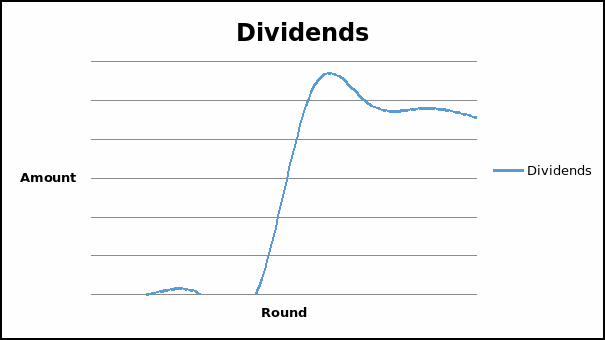
Earnings per share
Earnings per share denote the total amount of earnings that is attributable to the common shareholder. It is computed as shown below
Earnings per share = net income attributed to shareholders / the total number of shareholders.
The EPS highly depends on the number of shareholders in a company. It is the number of shareholders is increasing at a faster rate than the amount of net income, then the EPS will be declining. In the case of Andrews Company, both numbers of shareholders and the amount of net income are growing. Thus, earnings per share are also expected to grow (Holmes & Sugden, 2008).
References
Brigham, E., & Ehrhardt, M. (2009). Financial management theory and practice. USA: South-Western Cengage Learning.
Holmes, G., & Sugden, A. (2008). Interpreting company reports. UK: Prentice Hall.
